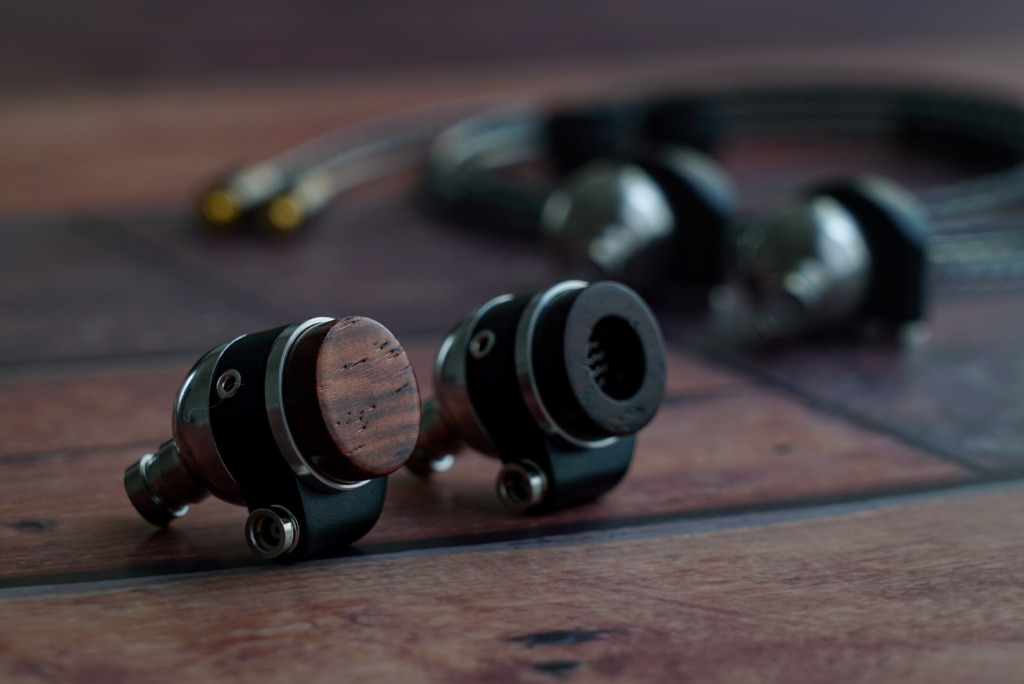LOAK2-TS(OP) is a model that has undergone a name change from the previous LOAK2(OP). While the housing configuration remains the same as the previous LOAK2(OP), we will provide explanations focusing on comparisons with other models in terms of sound.
Housing)
Front enclosure : Titanium.
Body enclosure : Stainless steel (only MMCX part is resin).
Rear enclosure : Various types of wood.


The front housing of the LOAK2 is nearly identical in shape to the previous LOAK, but the internal structure is slightly different, incorporating thin stainless steel in the area where the drivers are secured. While titanium and aluminum are excellent materials for transmitting sound from the drivers to the nozzle tip due to their low vibration damping, they are not as effective at dampening the vibrations of dynamic drivers. Therefore, by incorporating stainless steel into the contact surface of the drivers, we are able to effectively suppress the vibrations of the dynamic drivers and achieve powerful bass and stable sound without distortion.
The MMCX section is designed to be external to the housing that affects sound, and due to its slightly specialized structure, it is made from resin material using 3D printing.
For the open portion of the backplate, we have slightly increased the inner diameter compared to previous OPEN types. This is to slightly reduce the rebound of air inside the rear housing, making the movement of the diaphragm softer and clearly distinguishing it from CLOSED types.
The characteristics of sound and comparison with other models)
The sound of LOAK2-TS(OP) is characterized by its delicacy, lightness, and expansive spatial representation, offering a pleasant listening experience. It features thin sound lines, high resolution, and a clear, crisp sound. Among the LOAK2 series, it has the weakest bass, but the subdued bass allows the treble to stand out.

Comparison of sound with LOAK2-TX03:
The flagship model LOAK2-TX03 shares similarities in tuning with the driver section, but the 3D printed housing of TX03 provides stronger bass and a better balance across the low, mid, and high frequencies. One significant difference is that TX03 is very mild, soft, and smooth, while TS(OP) has excellent treble extension but a sharper, harder sound. The attack and peaks in the high frequencies are also stronger in TS(OP). In terms of the softness of the sound, these two models can be considered polar opposites.
Comparison of sound with LOAK2-Ti(OP):
The LOAK2-Ti(CL) with its titanium body not only differs in housing but also in driver tuning compared to TS(OP). While TS(OP) offers a detailed and clear sound profile, Ti(CL) provides a thicker sound with more emphasis on the mid-bass. These two models can be said to have completely opposite directions in terms of sound characteristics.

Regarding the choice of backplate)
This model is of the open type (OP), so the difference in sound based on the type of wood or metal used in the rear housing is relatively small compared to the closed type (CL). Regardless of the chosen wood, there is no significant difference in the sound of LOAK2-Ti(OP), and the choice of material does not result in as significant a change as it would in other models. However, when compared side by side, there are slight discernible differences in sound.
For those who prefer a crisp sound with clear contours, I recommend using hard and dense woods. Ebony or even harder woods would be suitable for this purpose.
For a slightly milder sound, I suggest using woods that are not overly hard. Woods softer than rosewood would be preferable.
If you also seek lightness and gentle sound, woods with density that is not excessively high would be preferable.
I chose Ching-chan wood. This wood has high hardness and density, making it one of the few woods in the 634EARS wood hardness-density chart where “hardness > density.” This type of wood tends to provide a clear and crisp mid-bass and a sense of lightness. While the sound lines are thin, they offer strong contrast and a clear sound.




